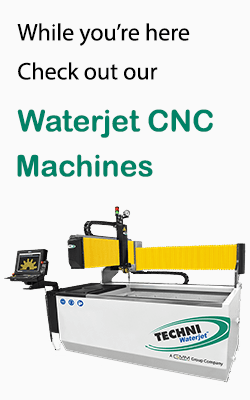The destructive force of water is so much that it can cut through the strongest of materials. This principle is utilized by waterjet cutting machines for industrial applications.
Many manufacturers often wonder about the applications of waterjet cutting machines. If you also wonder about what materials can be cut with waterjet cutting machines, this article is the perfect place for you.
In the sections to come, we will discuss the various industries which employ water jet cutting machine applications. You will also learn about the compatible and non-compatible materials for these types of machines.
What are the applications of a waterjet cutting machine?
Water jet cutting machines are straightaway one of the most versatile industrial equipment out there. When we question the applications of these cutting machines, the possibilities are endless. The cutting action of these cutters is achieved through high-speed water created by a high-pressure pump.
While pure waterjet cutters are quite powerful on their own, waterjet cutting commonly utilizes the addition of abrasive materials in the water. These abrasives increase the cutting force of the resultant stream manifold, and the process is called abrasive waterjet cutting.
Here is the list of materials that can be cut by a water jet cutting process, along with the maximum thickness of material that can be cut:
1. Stones & Tiles Cutting
With the addition of abrasives, water jet cutting machines can make precise cuts in granite, marble, porcelain, Dekton, Caesarstone, neolith, ceramics, stone, and tiles.
For cutting ceramic tiles, the maximum thickness supported by waterjet cutters is 2 inches. For marble and granite, waterjet can cut a thickness of up to 6 inches.
2. Glass Cutting
Glass is delicate and can crack easily during the conventional cutting processes. This is why water jet cutting is one of the most commonly used technologies for glass cutting. The 5-axis waterjet cutters allow even intricate cut designs to be placed on a glass workpiece. It is utilized for making cut-outs, frameless showers, holes in splashbacks, and glass architectural applications. For cutting glass with a water jet cutter, there are also a lot of compatible handling devices available at Techniwaterjet that allow for smoother loading and unloading of the product.
For cutting glass, a water jet cutter supports a maximum thickness of 7 inches.
3. Metal Cutting
Water jet cutting can be used to cut any metal like Aluminium, hardened tool steel, titanium, copper, brass, or any other exotic metals. Since water jet cutting does not cause any temperature rise, the structural and chemical integrity of the workpiece remains intact.
The maximum cutting thickness of water jet cutting varies based on the metal. For aluminum, it is 18 inches; for steel 12 inches, and 10 inches for brass and copper.
4. Ceramics
Ceramics are hard-to-machine due to their toughness and often require expensive saw blades. This is why water jet cutting turns out to be a cheaper cutting technique for ceramics.
It can cut ceramics up to a thickness of 8 inches.
5. Plastics
When plastics are subjected to high-temperature tools, it leads to the production of toxic fumes. Therefore, water jet cutting is the safest option for cutting plastics as no temperature rise takes place.
It can cut up to a thickness of 4 inches for the hardest acrylics.
6. Foam and Rubber
Similar to plastic, rubber also releases toxic fumes at high temperatures. Manufacturers around the world use waterjet cutting for processing rubber due to its safety benefits.
This method supports a maximum cutting thickness of 10 inches for rubber and 30 inches for foam.
7. Textiles
Textiles are very flammable and can catch fire easily with any temperature rise. Waterjet technology is commonly used in textile and fabric cutting applications as it is a cold-cutting method.
It can cut textiles up to 2 inches.
8. Composites
Composites, such as fiberglass and carbon fiber, are common nowadays in a wide array of applications. These composites are soft materials for common cutting methods and can strain or crack when improper force is applied. Waterjet cutting turns out to be one of the best cutting technologies for composites since the force is limited to the point of impact only.
For composites, it can cut a maximum thickness of 6 inches.
9. Food
Food processing industries require a cutting method that involves high cleanliness and no heat changes. Waterjet cutting fits the bill perfectly since it is a cold cutting method with no physical impact of the tool with the cutting surface.
10. Paper and Cardboard
On first impression, it might seem that water jet cutting will be inappropriate for paper as the paper will get wet and ruined. However, the process has been used in the industry for decades now.
For paper cutting, the stream of the water jet is modified and the process is called slitting. It uses a very narrow stream of water that is thinner than even human hair, coupled with high pressure pumps.
11. Insulation Materials
Water jet cutting is also used to make precise cuts on insulation materials such as HVAC liners and PU rubber.
For hard insulation materials, the process can cut a thickness up to 4 inches.
12. Cement Boards
Cement boards are hard to cut with conventional methods. However, with a waterjet cutter, you can make accurate angular cuts on these boards.
For cement boards, the waterjet cutters can support a maximum thickness of 4 inches.
Utilizing one of the most versatile cutting methods it is clear that waterjet machines can cut a variety of materials. Some of the main benefits are highly accurate cutting and low material wastage.
What industries use waterjet cutters?
As waterjet cutters support a wide range of materials, they are used by a lot of different industries. The main factor that leads to the popularity of this method is that water jet offers countless benefits over other alternatives such as laser cutting. Here is a brief description of the various applications of this method:
Food Cutting & Food Processing Equipment
- Waterjet cutting is the preferable method in the food processing industry. This is because this cutting method involves high sanitation, and preserves the integrity of the food without contaminating it.
- This method is heavily used for meat processing, vegetable slicing, and manufacturing snacks and cake products.
- Since waterjet cutting eliminates the need for manual tools such as knives, it significantly increases the safety of the workers in the food processing facility.
Aerospace industry
- The aerospace industry involves working with toughened substances that require precise cuts. Waterjet cutting is used in the aerospace industry for all these requirements, especially when making turbine blades, parts of a jet engine, or cutting composite materials for aircraft.
Automotive industry
- Waterjet cutters are installed in the production line of the automotive industry. These cutters make the required incisions for fine engine components of automotive and other gear parts.
Defence and Military
- The complex components used in defense and military sectors are created by waterjet cutters. Usually, 5-axis or 6-axis cutters are employed for the purpose. Extra hard materials like kevlar composites are also cut through this method.
Rubber & Composites Cutting
- Waterjet cutting is used to cut rubber and composite materials for boat shells, panel insulations, home insulations, personal watercraft bodies, etc.
- The benefit that this method offers is that cutting can be achieved without melting the workpiece, and without releasing any toxic fumes.
Medical & Surgical Equipment
- The wide versatility and high cutting precision of waterjet cutting make it the perfect fit for cutting materials for medical and surgical equipment. These materials constantly evolve with engineering advancements, so the cuts can be made and modified as per requirements.
- Due to the possibility of angular cuts, it is used to make complex equipment for liposuction applicators, liver resection, bone divisions, etc.
Architectural & Art Work
- Waterjet cutting is commonly used for cutting fiberglass, metals, cement boards, and other materials used in architectural and construction work.
- Complex architectural artwork in false ceilings and other installations is also created by waterjet cutters.
- Since waterjet cutting does not cause any jagged edges, it is also used for the cutting of wallpapers.
Electronics
- Electronic and microelectronic components are highly sensitive to heat. Their electrical properties can change if heat-affected zones are created. This is why a highly precise cold cutting process like abrasive waterjet cutting technology is perfect for the electronics industry.
Job Shops
- Job shops often handle a lot of different materials and a lot of different cutting requirements. Therefore, abrasive waterjet cutters are used in job shops because they offer the most versatility among any professional cutting process.
Metal Service Centres
- Metal service centers require a cutting method that can work on a large area of material with a high cutting speed. This is why waterjet cutting is used in the industry extensively.
- Another benefit of waterjet cutting is that it can perfectly work on metals that are poor conductors of electricity. For arc-based cutting technologies, that is not the case.
Education & Research
- Waterjet cutting is also used for making prototypes and models of products in the research phase. With angular cuts and high precision, the prototypes created with waterjet cutting can be made to look as intended by the imagination.
Experimental & Laboratory Environments
- Abrasive waterjet cutting works quite well for common lab equipment such as stainless steel and alloys. It can handle all the materials used to make experimental equipment.
- The structural integrity of the component is preserved and the tolerances are known beforehand. Therefore, this cutting method can also be used to make graded equipment such as calipers and rulers.
Oil & Gas
- Abrasive waterjet cutting is utilized to cut materials like Inconel, Hastelloy, and stainless steel for oil and gas subsea equipment.
- One of the major benefits is that since there are no heat-affect zones, the abrasive waterjet cut equipment is more reliable than other heat cutting alternatives.
Mining
- Abrasive waterjet cutting is extensively used for mining coal and other natural substances. In fact, specialized waterjet cutters for mining can cut stone up to a thickness of 100 feet!
Waterjet cutting applications – things to remember
When we are discussing waterjet cutting applications, there are certain things you should remember:
- When cutting a pre-required shape out of a material with waterjet cutting, different layers of the material are stacked on top of each other. It increases the efficiency of the actual cutting process significantly and is known as Stacking.
- The whole process of waterjet technology is completely recyclable. The waterjet cutters follow a closed-loop system, and all the water used in the process is recycled to be used over and over. This makes it suitable even in areas that face water shortages.
- Almost every other cutting method creates a high-temperature area adjacent to the cut, known as Heat-affected zones. In waterjet cutting, there is no physical contact of the cutting head with the workpiece. Therefore, there is no formation of heat-affected zones.
- Heat-affected zones can alter the chemical composition and the physical structure of the material. Therefore, waterjet technology is the perfect technology for any application that aims to maintain the integrity of the material.
- Waterjet cutters can be loaded with CAD designs to create any required cuts automatically. For common cutting applications, the CAD designs are readily available online.
Conclusion
As you can see, the application of waterjet cutting is so versatile that almost every industry uses it in one way or another. Waterjet cutting is far superior to any other cutting alternatives, making it ideal for all industrial operations regardless of their scale.
If you are considering waterjet cutting for your shop or industry, you can check the range of waterjet cutters available at TechniWaterjet. These waterjet cutters are highly reliable, industry-leading equipment capable of handling whatever you throw at them.
Additionally, TechniWaterjet also provides compatible software for their waterjet cutters. These software come with pre-loaded CAD designs to create quick cuts, and the ability to create any customized designs as well.





